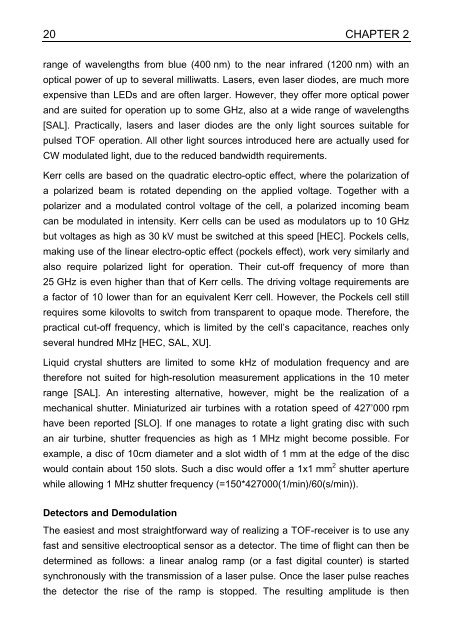3D Time-of-flight distance measurement with custom - Universität ...
3D Time-of-flight distance measurement with custom - Universität ...
3D Time-of-flight distance measurement with custom - Universität ...
You also want an ePaper? Increase the reach of your titles
YUMPU automatically turns print PDFs into web optimized ePapers that Google loves.
20 CHAPTER 2<br />
range <strong>of</strong> wavelengths from blue (400 nm) to the near infrared (1200 nm) <strong>with</strong> an<br />
optical power <strong>of</strong> up to several milliwatts. Lasers, even laser diodes, are much more<br />
expensive than LEDs and are <strong>of</strong>ten larger. However, they <strong>of</strong>fer more optical power<br />
and are suited for operation up to some GHz, also at a wide range <strong>of</strong> wavelengths<br />
[SAL]. Practically, lasers and laser diodes are the only light sources suitable for<br />
pulsed TOF operation. All other light sources introduced here are actually used for<br />
CW modulated light, due to the reduced bandwidth requirements.<br />
Kerr cells are based on the quadratic electro-optic effect, where the polarization <strong>of</strong><br />
a polarized beam is rotated depending on the applied voltage. Together <strong>with</strong> a<br />
polarizer and a modulated control voltage <strong>of</strong> the cell, a polarized incoming beam<br />
can be modulated in intensity. Kerr cells can be used as modulators up to 10 GHz<br />
but voltages as high as 30 kV must be switched at this speed [HEC]. Pockels cells,<br />
making use <strong>of</strong> the linear electro-optic effect (pockels effect), work very similarly and<br />
also require polarized light for operation. Their cut-<strong>of</strong>f frequency <strong>of</strong> more than<br />
25 GHz is even higher than that <strong>of</strong> Kerr cells. The driving voltage requirements are<br />
a factor <strong>of</strong> 10 lower than for an equivalent Kerr cell. However, the Pockels cell still<br />
requires some kilovolts to switch from transparent to opaque mode. Therefore, the<br />
practical cut-<strong>of</strong>f frequency, which is limited by the cell’s capacitance, reaches only<br />
several hundred MHz [HEC, SAL, XU].<br />
Liquid crystal shutters are limited to some kHz <strong>of</strong> modulation frequency and are<br />
therefore not suited for high-resolution <strong>measurement</strong> applications in the 10 meter<br />
range [SAL]. An interesting alternative, however, might be the realization <strong>of</strong> a<br />
mechanical shutter. Miniaturized air turbines <strong>with</strong> a rotation speed <strong>of</strong> 427’000 rpm<br />
have been reported [SLO]. If one manages to rotate a light grating disc <strong>with</strong> such<br />
an air turbine, shutter frequencies as high as 1 MHz might become possible. For<br />
example, a disc <strong>of</strong> 10cm diameter and a slot width <strong>of</strong> 1 mm at the edge <strong>of</strong> the disc<br />
would contain about 150 slots. Such a disc would <strong>of</strong>fer a 1x1 mm 2 shutter aperture<br />
while allowing 1 MHz shutter frequency (=150*427000(1/min)/60(s/min)).<br />
Detectors and Demodulation<br />
The easiest and most straightforward way <strong>of</strong> realizing a TOF-receiver is to use any<br />
fast and sensitive electrooptical sensor as a detector. The time <strong>of</strong> <strong>flight</strong> can then be<br />
determined as follows: a linear analog ramp (or a fast digital counter) is started<br />
synchronously <strong>with</strong> the transmission <strong>of</strong> a laser pulse. Once the laser pulse reaches<br />
the detector the rise <strong>of</strong> the ramp is stopped. The resulting amplitude is then

















